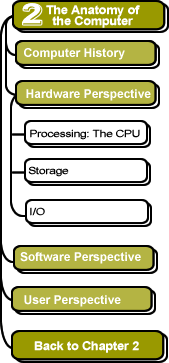

|
Output Devices
Again, as we have learned, the only thing a microprocessor does is to mimic binary arithmetic. Accordingly, in the most fundamental terms, output is simply the task of receiving back from the microprocessor the results of binary arithmetic tasks that it has performed.
Fortunately, the user only sees the results that have been decoded by various output devices:
 The
computer monitor - The computer graphics adapter translates 0s
and 1s into video signals for the computer monitor.
The
computer monitor - The computer graphics adapter translates 0s
and 1s into video signals for the computer monitor.
- Printers -
0s and 1s can also be translated into instructions that can be acted
upon by various printer technologies:
- laser printers
- ink-jet printers
Both input and output devices attach to the computer's internal communication "highways" (called buses) through a variety of ports on the computer's surface, including:
- serial ports
- parallel ports
- USB ports
- Firewire ports
Click here to see a simple animation of input and output as communication with the microprocessor.
![]()
![]()
These pages were written by Steven H. VanderLeest and Jeffrey Nyhoff and edited by Nancy Zylstra
©2005 Calvin University (formerly Calvin College), All Rights Reserved
If you encounter technical errors, contact computing@calvin.edu.